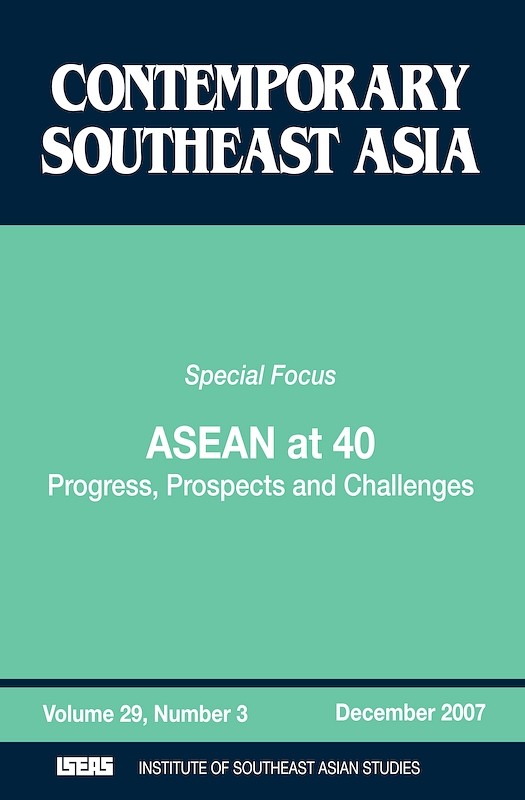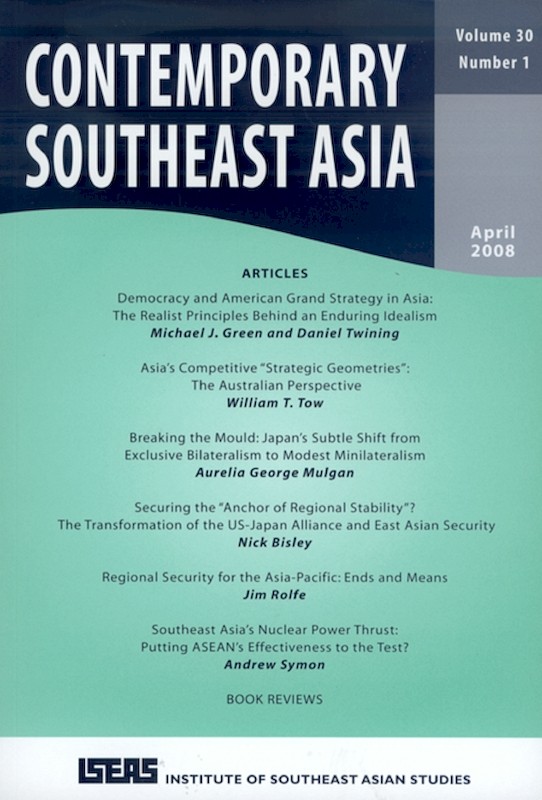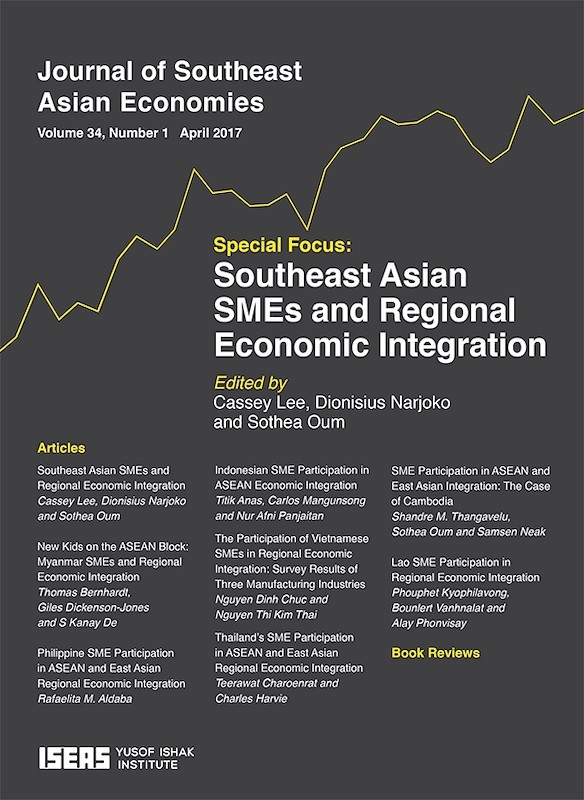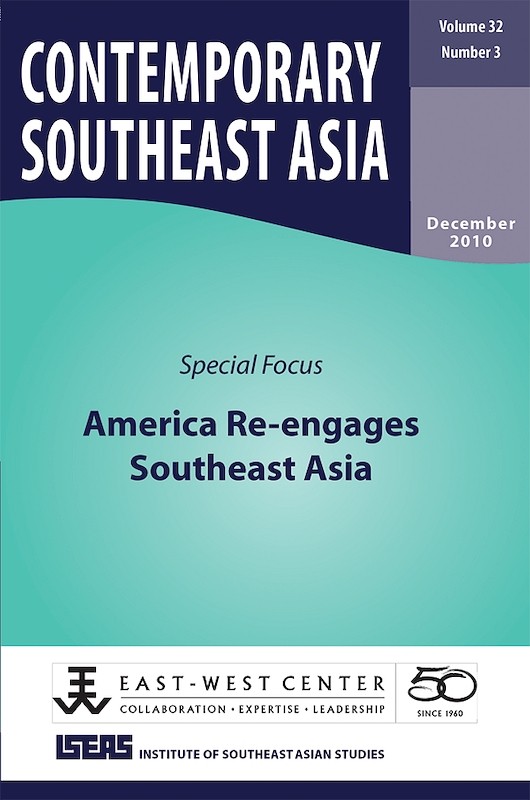Contemporary Southeast Asia: A Journal of International and Strategic Affairs. Vol. 29/3 (Dec 2007). Special Focus on ASEAN at 40: Progress, Prospects and Challenges

Date of publication:
December 2007
Number of pages:
148
Code:
CS29/3
Contents
-
Contemporary Southeast Asia: A Journal of International and Strategic Affairs. Vol. 29/3 (Dec 2007)
-
Preliminary pages
- ARTICLES
-
Introduction: ASEAN Facing the Fifth Decade, by Chin Kin Wah, author
-
ASEAN Beyond Forty: Towards Political and Economic Integration, by Rodolfo C Severino, author see abstractASEAN has come a long way since its founding in 1967. It has achieved a certain degree of political cohesion on some regional and international issues. It has helped keep the peace among its members. It has adopted norms for inter-state relations and managed to get others to accede to those norms. It has healed the divisions in Southeast Asia. It has served as the core of regionalism in East Asia and the Asia Pacific. ASEAN has reduced or abolished tariffs on much intra-ASEAN trade and committed its members to other measures for the integration of the regional economy. It has established modes of cooperation in dealing with regional problems. However, ASEAN has fallen short of the ambitions that it has proclaimed for itself, particularly in terms of driving regionalism and regional economic integration. A major reason for this is the fact that political cohesion and economic integration are pursued independently of each other. Here, regional institutions could help in formulating, for the member states' adoption, a regional outlook and coordinating politics and economics as a coherent whole.
-
Challenging ASEAN: A "Topological" View, by Donald K Emmerson, author see abstractThe 40th anniversary of the Association of Southeast Asian Nations (ASEAN) is an opportunity to consider the ways in which the Association is a challenge to its analysts and is itself challenged by issues and circumstances. Among the analytic challenges is the necessity but also the difficulty of distinguishing Southeast Asia the region from ASEAN the organization. The more ASEAN claims and tries to transform Southeast Asia into a community, and the more the Association is challenged by questions of democracy, the more useful this analytic distinction becomes. Conflating the region and the organization precludes asking two very different questions about democracy: On the one hand, can and should ASEAN try to make the region more democratic? On the other, can and should ASEAN itself become more democratic? The first task is daunting in a region where only one country -- Indonesia -- is rated "free" by Freedom House. But the "non-interference" principle, on closer inspection, does not preclude adding democracy to ASEAN's agenda. The second task will depend in part on the content of ASEAN's new charter and how much its provisions will matter. How, in particular, will the Association as a consociational body practicing "horizontal" or inter-elite democracy respond to the presently steep inequality between its member governments and its Secretariat? In this "topological" picture, ASEAN's member states are mountains of unequal height surrounding the Secretariat as a basin. Could elevating the basin -- empowering the Secretary-General -- help ASEAN retain credibility as an organization with a more than contingent interest in democracy and human rights? Evidence from the 2007 crisis in Myanmar, the Association's delayed response to that crisis, and the background of the incoming Secretary-General suggest that the answer is yes.
-
United States-ASEAN Relations on ASEAN's Fortieth Anniversary: A Glass Half Full, by Satu P Limaye, author see abstractAs ASEAN marks its 40th anniversary, US-ASEAN relations, for all their complexities and dissonances, also show signs of success and potential future growth. Viewed from the perspective of where US-ASEAN relations were four decades ago, signs of structural change and the prospect of a more focused- and action-oriented ASEAN organization, there remains every possibility of further filling a glass of interactions that is now only half full. The US is considering several ways in which to enhance its relations with ASEAN including through signing the Treaty of Amity and Cooperation, appointing an ambassador to ASEAN and participating in a range of regional and bilateral activities in the economic, political and military realms. It is quite likely that the US will take one or more of these measures to demonstrate its commitment to ASEAN. However, the ultimate guarantor of strengthened US-ASEAN relations will be the ability of member countries to demonstrate that they as individual countries and as ASEAN can be and wish to be partners of the US in this new century.
-
ASEAN's Relations with the European Union: Obstacles and Opportunities, by J Oerstroem Moeller, author see abstractThe European Union (EU) and ASEAN have over the years come to appreciate each other as important and reliable partners sharing the same basic outlook on global politics and economics. Gradually a mechanism for consultation has been built up and it seems to work well despite some problems. Nevertheless it is puzzling why the relationship has not moved from a consultative one to a more substantive one. One reason may be that trade and investment flow smoothly without a formalized framework. This is, however, not a convincing reason. It is more likely that the EU and ASEAN have never really fully understood each other, what their respective objectives are and how they work. In 2006 the EU finally opened the door to negotiations for a free trade agreement with ASEAN, something, which had been on the ASEAN wish list for a number for years. Hopefully this will pave the way for a relationship not only rich in declarations and good intentions, but also of substantial character.
-
Vietnam's Membership of ASEAN: A Constructivist Interpretation, by Nguyen Vu Tung, author see abstractVietnam's membership of ASEAN was driven by pragmatic reasons of economic growth, political independence and regime survival in a post Cold War environment. But in fact the learning process -- which made Vietnamese decision-makers through their first-hand experiences more aware of convergent domestic and foreign policy goals between Vietnam and ASEAN -- was instrumental in Vietnam's decision to seek ASEAN membership as quickly as possible. The case of Vietnam joining ASEAN then shows that the process of socialization and interactions between Vietnam and ASEAN countries helped improve the awareness of commonalities and promoted cooperative relations. And this is one of the main arguments in the constructivist approach to international cooperation based on the self-other internalization. In this connection, Vietnam joining ASEAN was also part of a broader process in which the country forged a new state identity in the post-Cold War era: Vietnam opted for ASEAN membership to overcome an identity crisis and political isolation. The ideational approach, therefore, offers an additional and more plausible explanation for Vietnam's decision to join ASEAN. Moreover, it helps explain Vietnam's continued satisfaction with and commitment to membership of ASEAN.
-
International Regime-Building in ASEAN: Cooperation against the Illicit Trafficking and Abuse of Drugs, by Ralf Emmers, author see abstractIn the context of its 40th anniversary, this article analyses how the Association of Southeast Asian Nations (ASEAN) has sought to deal with the problem of drug production, trafficking and consumption in Southeast Asia. Reviewing more than three decades of cooperation, it asks whether an international regime against the illicit trafficking and abuse of drugs has been established in the region under the auspices of ASEAN. In particular, the paper discusses the ASEAN and China Cooperative Operations in Response to Dangerous Drugs (ACCORD) as an attempt to create a framework of multilateral cooperation. It argues however that it is still premature today to characterise existing regional consultations as a working anti-drug regime. The existing cooperative structure has remained a loose forum for information sharing despite the strong Chinese involvement that has deepened consultations since the late 1990s.
- BOOK REVIEWS
-
BOOK REVIEW: Charm Offensive: How China's Soft Power is Transforming the World, by Joshua Kurlantzick, and The Dragon Looks South: China and Southeast Asia in the New Century, by Bronson Percival, by Robert Sutter, author
-
BOOK REVIEW: The King Never Smiles: A Biography of Thailand's Bhumipol Adulyadej, by Paul M. Handley, by P W Chambers, author
-
BOOK REVIEW: Vientiane: Transformations of a Lao Landscape, by Marc Askew, William S. Logan and Colin Long, by Grant Evans, author
-
BOOK REVIEW: Democratising Indonesia: The Challenges of Civil Society in the Era of Reformasi, by Mikaela Nyman, by Marcus Mietzner, author
-
BOOK REVIEW: Legitimizing Military Rule: Indonesian Armed Forces Ideology, 1958-2000, by Salim Said, and Soeharto's Armed Forces: Problems of Civil Military Relations in Indonesia, by Salim Said, by Douglas Kammen, author
-
BOOK REVIEW: Japan's Security Policy and the ASEAN Regional Forum: The Search for Multilateral Security in the Asia-Pacific, by Takeshi Yuzawa, by Yoichiro Sato, author






